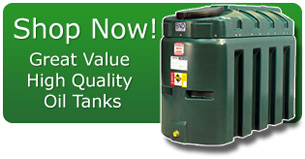Commercial Regulations
Environmental Hazards:
All oil tanks at commercial premises with a capacity in excess of 200 litres should either be bunded or contained within secondary containment that holds at least 110% of the primary tanks capacity.
This includes 45-gallon drums as they hold 205 litres.
Please browse our commercial oil tank services section for information on replacement tanks and tank upgrades.
Our oil tank supply section shows the range of tanks we have available, the range includes heating oil tanks, waste oil tanks and fuel stations.
For more information on the commercial bunding requirements please visit the Environment Agencies web site at: www.environment-agency.gov.uk and view Pollution Prevention Guidelines PPG2.
Fire Hazard:
Tanks below 3500 Litres in capacity:
The following regulations apply to oil tanks below 3500 litres in capacity:
Fire hazards relate to the siting of the tank and an potential fire risks within the close vicinity of the tank. If the answer is “yes” to the questions below, fire protection of no less than 60 minutes extending 900mm longer than each side of the oil storage tank and 900mm higher than the highest part of the oil storage tank is required.
Is the oil tank located within 2.0 m of a non-fire rated building or structure (less than 60 minutes)?
This includes timber sheds and any wall which doesn’t have a minimum 60 minutes fire resistance.
Is the oil tank located within 2.0 m of a non-fire rated boundary (less than 60 minutes)?
If the tank is against a stone boundary wall, the wall should exceed 900mm beyond the height and ends of the tank and have 60 minutes fire resistance for it to be considered fire rated.
Is the oil tank located within 2.0 m of non-fire rated eaves?
Is the oil tank located within 2.0 m of construction opening in a building (window/door)?
Is the oil tank located on a base which does not extend a minimum of 300mm around all sides of the tank?
If the existing base does not extend 300mm on all sides of the tank it will need to be extended so that it is 300mm larger than the tank on all sides. The only exception to the base rule is where the side and/or end of the base abuts a fire rated structure, such as a building, barriers or boundary. In these circumstances the base need only extend 100mm from the tank to the fire rated structure. Any exposed sides or ends should still be extended by 300mm.
It is also recommended that tanks below 3500 litres capacity have a minimum of 100mm between the tank and any adjacent structure to allow for flexing and inspection. Some tank manufacturers may require a greater distance.
Tanks above 3500 Litres in capacity:
The following regulations apply to oil tanks above 3500 litres in capacity:
Fire hazards relate to the siting of the tank and any potential fire risks within the close vicinity of the tank. If the answer is “yes” to the questions below, fire protection of no less than 120 minutes extending 900mm longer than each side of the oil storage tank and 900mm higher than the highest part of the oil storage tank is required.
Is the oil tank located within 6.0 m of a non-fire rated building or structure (less than 120 minutes)?
This includes timber sheds and any wall which doesn’t have a minimum 120 minutes fire resistance.
Is the oil tank located within 6.0 m of a non-fire rated boundary (less than 60 minutes)?
If the tank is against a stone boundary wall, the wall should exceed 900mm beyond the height and ends of the tank and have 60 minutes fire resistance for it to be considered fire rated.
Is the oil tank located within 1.8 m of construction opening in a building (window/door)?
Note any openings in walls between 1.8 m and 6m away from the oil storage tank should be fitted with 60 minute fire rated glazing or 60 minute fire rated self closing doors.
Is the oil tank located on a base which does not extend a minimum of 300mm around all sides of the tank?
If the existing base does not extend 300mm on all sides of the tank it will need to be extended so that it is 300mm larger than the tank on all sides.
When installing a tank in excess of 3500 litres capacity, consult the manufacturer for the required distance between the tank and any adjacent structure to allow for flexing and inspection. Also it is recommended that you contact the local fire authority and property insurers for further guidance.
Please note that these regulations apply to externally located tanks only. Tanks located inside a building should be bunded and contained within a fireproof chamber. For more information on installing tanks internally please either contact us or visit www.oftec.org
The most cost effective way to install the new tank is to position it so that it complies without the need for fire protection!
